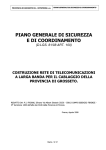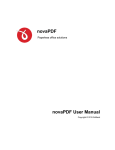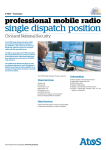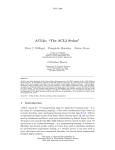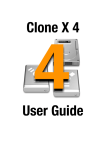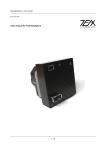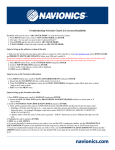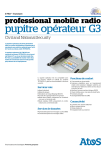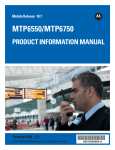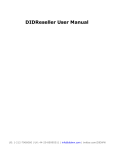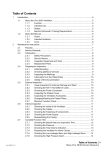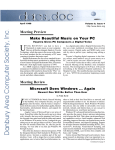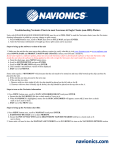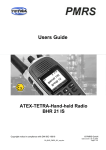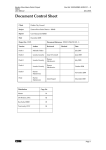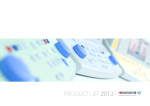Download PDF
Transcript
ID: ISITEP_D5.1.1_20140609_V1.2
Inter System Interoperability
D5.1.1 DRAFT ENHANCED TERMINAL
REQUIREMENTS
Document Manager:
Federica Battisti
RM3
Programme:
Inter System Interoperability for Tetra-TetraPol Networks
Project Acronym:
ISITEP
Contract Number:
312484
Project Coordinator:
Selex ES
SP Leader:
RM3
Document ID N°:
ISITEP_D5.1.1_20140609_V1.2
Deliverable:
D5.1.1
Document
classification
Editor
Version:
V1.2
Date:
09/06/2014
Status:
Approved
PUblic
Approval Status
Prepared by:
Federica Battisti (RM3)
Approved by (WP Leader):
Alessandro Neri (RM3)
Approved by (SP Leader):
Alessandro Neri (RM3)
Approved by (Coordinator)
Claudio Becchetti (SES)
Security Approval
Etienne Lezaack (BFP)
(Advisory Board Coordinator)
Date: 9-06-2014
Approval status: Approved
Page 1/43
This document is produced under the EC contract 312484. It is the property of the ISITEP Parties and shall not be
distributed or reproduced without the formal approval of the ISITEP Steering Committee
ID: ISITEP_D5.1.1_20140609_V1.2
CONTRIBUTING PARTNERS
Name
Company / Organization
Role / Title
Federico Frosali
SES
Contributor
Claudia Olivieri
SES
Contributor
Michela Cancellaro
RM3
Contributor
Federica Battisti
RM3
Contributor
Ramon Ferrus
UPC
Contributor
Jakko Saijonmaa
CAS FI
Contributor
Serge Delmas
CAS FR
Contributor
DISTRIBUTION LIST
Name
Company / Organization
Role / Title
All Company Project
Managers
All involved companies
Members of the Steering
Committee
Elina MANOVA
EC DG REA
EC Programme Officer
REVISION TABLE
Version
Date
Modified
Pages
Modified
Sections
Comments
V0.0
12/12/2014
All
All
Template issued
V1.0
22/04/2014
All
All
First draft
V1.1
15/05/2014
All
All
Draft with comments
V1.2
09/06/2014
All
All
Final revision
Date: 9-06-2014
Approval status: Approved
Page 2/43
This document is produced under the EC contract 312484. It is the property of the ISITEP Parties and shall not be
distributed or reproduced without the formal approval of the ISITEP Steering Committee
ID: ISITEP_D5.1.1_20140609_V1.2
Publishable extended abstract
This deliverable (D5.1.1) is the first deliverable issued by WP5.1.
It reports on the advances in Task 5.1.1 until M06.
In particular, the following points are covered:
the analysis of PPDR user needs;
the analysis of existing PPDR terminals;
the definition of requirements for "application enabled" bi-technology terminals;
the requirements for interoperability functions;
the requirements for PPDR cloud added value functions and applications.
Date: 9-06-2014
Approval status: Approved
Page 3/43
This document is produced under the EC contract 312484. It is the property of the ISITEP Parties and shall not be
distributed or reproduced without the formal approval of the ISITEP Steering Committee
ID: ISITEP_D5.1.1_20140609_V1.2
CONTENTS
1
INTRODUCTION ............................................................................................................................ 5
2
DEFINITIONS AND ABBREVIATIONS ......................................................................................... 6
2.1
2.2
3
ENHANCED TERMINAL REQUIREMENTS DEVELOPMENT FRAMEWORK ............................ 9
3.1
4
System Overview .................................................................................................................... 9
ANALYSIS OF PPDR NEEDS ..................................................................................................... 12
4.1
4.2
4.3
5
Definitions ............................................................................................................................... 6
Abbreviations .......................................................................................................................... 6
Analysis of Security Requirements ..................................................................................... 12
Analysis of End-User Requirements ................................................................................... 12
Analysis of existing PPDR terminals and smart device .................................................... 16
TERMINAL REQUIREMENTS ..................................................................................................... 22
5.1
5.2
5.3
5.4
5.5
General Requirements.......................................................................................................... 23
Interface Requirements ........................................................................................................ 25
Requirements for bi-technology terminals “application enabled” .................................. 25
Requirement for interoperability functions ........................................................................ 33
Requirements for PPDR cloud added value functions and applications. ....................... 37
6
CONCLUSIONS ........................................................................................................................... 42
7
REFERENCES ............................................................................................................................. 43
Date: 9-06-2014
Approval status: Approved
Page 4/43
This document is produced under the EC contract 312484. It is the property of the ISITEP Parties and shall not be
distributed or reproduced without the formal approval of the ISITEP Steering Committee
ID: ISITEP_D5.1.1_20140609_V1.2
1
INTRODUCTION
The aim of WP 5.1 is the definition of the requirements and the architecture of vehicular/hand-held
enhanced terminals based on the TETRA/TETRAPOL technology. Such terminals will rely on the use
of programmable devices such as smartphones and tablets.
The outcome of this WP is the definition of the architecture of the new terminal and of its services.
This WP is strategic because its outputs will be used for the definition of the
Adaptation/Communication Manager (WP 5.2), the Security Manager (WP 5.3), the Workflow
Manager (WP5.4), the Semantic/Syntactic Translator (WP 5.5) and the User Interface and Business
Logic Manager (WP 5.6).
Date: 9-06-2014
Approval status: Approved
Page 5/43
This document is produced under the EC contract 312484. It is the property of the ISITEP Parties and shall not be
distributed or reproduced without the formal approval of the ISITEP Steering Committee
ID: ISITEP_D5.1.1_20140609_V1.2
2
DEFINITIONS AND ABBREVIATIONS
2.1 Definitions
This section is intended to capture the definitions of some key terms used in the document for the
purpose of increased consistency. Most of the definitions are obtained from official 3GPP and ETSI
documents:
Access control: the prevention of unauthorized use of resources, including the use of a resource in
an unauthorized manner.
Authentication: the act of positively verifying that the true identity of an entity (network, user) is the
same as the claimed identity.
Confidentiality: the property that information may not be available or disclosed to unauthorized
individuals, entities or processes.
Data integrity: the property that data has not been altered or destroyed in an unauthorized manner.
Encryption: the conversion of plaintext to ciphertext.
Key: a sequence of symbols that controls the operations of encipherment and decipherment.
Key management: the generation, selection, storage, distribution, deletion, archiving and application
of keys in accordance with a security policy.
Migration: act of changing to a location area in another network (either with different Mobile Network
Code and/or Mobile Country Code) where the user does not have subscription (e.g. ITSI in TETRA)
for that network. In this document, migration is used as a synonym of roaming.
Profile: the capability of a particular equipment. This is defined separately for individual subscriber
terminals and individual infrastructures.
Provision: the act of supplying a given service (Note: A communication system may be capable of
supporting a service. However, it may not supply the service to certain subscriber terminals for which
the service is not subscribed.)
Roaming: utilization of a mobile terminal in a network other than the one where the mobile is
subscribed but on which the mobile can still be located and operated by agreement between the
respective network operators.
2.2 Abbreviations
For the purposes of the present document, the following abbreviations apply:
Acronym
Definition
3GPP
ACM
AI
AIE
AuC
CCK
DCK
DMO
E2EE
3rd Generation Partnership Project
Adaptation and Communication Manager
Air Interface
Air Interface Encryption
Authentication Center
Common Cipher Key
Derived Cipher Key
Direct Mode Operation
End to End Encryption
Date: 9-06-2014
Approval status: Approved
Page 6/43
This document is produced under the EC contract 312484. It is the property of the ISITEP Parties and shall not be
distributed or reproduced without the formal approval of the ISITEP Steering Committee
ID: ISITEP_D5.1.1_20140609_V1.2
ESI
GMO
GNSS
GTSI
HMI
IOP
IP
ISI
ISSI
ITSI
KMC
KSS
MCC
MNC
MoU
MNI
MS
MT
NGN
OTAR
PC
PDA
PEI
PMR
PPDR
PS
PSTN
RMO
RS
RSSI
SCK
SDS
SFPG
SIM
SM
SST
SwMI
TAA1
TE
TEAx
TEDS
TEI
TETRA
TMO
UI&BL
VoIP
VPN
WM
WS
Encrypted Short Identity
Gateway Mode Operation
Global Navigation Satellite System
Group TETRA Subscriber Identity
Human Machine Interface
Interoperability Profile
Internet Protocol
Inter System Interface
Individual Short Subscriber Identity
Individual TETRA Subscriber Identity
Key Management Center
Key Stream Segment
Mobile Country Code
Mobile Network Code
Memorandum of Understanding
Mobile Network Identity
Mobile Station
Mobile Terminal
Next Generation Network
Over The Air Rekeying
Professional Computer
Personal Digital Assistant
Peripheral Equipment Interface
Professional/Private Mobile Radio
Public Protection and Disaster Relief
Public Safety
Public Switched Telecommunications Network
Repeater Mode Operation
Random Seed
Received Signal Strength Indication
Static Cipher Key
Short Data Service
Security and Fraud Prevention Group
Subscriber Identity Module
Security Manager
Semantic and Syntactic Translator
Switching and Management Infrastructure
TETRA Authentication and key management Algorithm suite 1
Terminal Equipment
TETRA Encryption Algorithm number x
TETRA Enhanced Data Services
Terminal Equipment Identity
TErrestrial Trunked Radio
Trunked Mode Operation
User Interface Adaptor & Business Logic
Voice over IP
Virtual Private Network
Workflow manager
Work station
Date: 9-06-2014
Approval status: Approved
Page 7/43
This document is produced under the EC contract 312484. It is the property of the ISITEP Parties and shall not be
distributed or reproduced without the formal approval of the ISITEP Steering Committee
ID: ISITEP_D5.1.1_20140609_V1.2
Date: 9-06-2014
Approval status: Approved
Page 8/43
This document is produced under the EC contract 312484. It is the property of the ISITEP Parties and shall not be
distributed or reproduced without the formal approval of the ISITEP Steering Committee
ID: ISITEP_D5.1.1_20140609_V1.2
3
ENHANCED TERMINAL REQUIREMENTS DEVELOPMENT FRAMEWORK
3.1 System Overview
Two different deployments of the enhanced ISITEP terminal are required: the vehicular one and only
as proof of concept the hand-held one. Both versions are based on the use of a smart device running
the Android Operating System, a tablet PC for the vehicular solution while smarthphone device for the
hand-held one.
TETRA and TETRAPOL air interface are provided by legacy TETRA and TETRAPOL modems even if
the right approach for the development of a new advanced bi-technology device would be the use of
the Software Defined Radio (SDR) technology. Unfortunately the SDR approach would require the
development of specific TETRA and TETRAPOL waveform, which is unfeasible with the timeframe of
the ISITEP project.
In order to realize a bi-technology terminal the smart device shall be able to manage the legacy
TETRA and TETRAPOL modems, indeed in both solutions the smart device shall host the MMI of the
enhanced ISITEP terminal, an adaptation layer for the communication with the legacy TETRA and
TETRAPOL modem and all the ISITEP applications.
TETRA and TETRAPOL modems shall be physically connected to the smart device in order to allow
the communication between the smart device and the TETRA and TETRAPOL modems.
In the ISITEP hand-held at least one of the TETRA/TETRAPOL modem shall be integrated inside the
smart device in order to avoid having three terminals, currently end-users, that have to participate to
those cross-border PPDR operations where both TETRA and TETRAPOL are used, are equipped
with only two terminals: a TETRA one and a TETRAPOL one.
On the other hand in the vehicular solution the legacy modems are installed inside a car and they may
be external to the smart device.
Legacy TETRA and TETRAPOL modems provide the following signalling and audio interface:
-
-
TETRA provides a standard signalling to interface the terminal equipment that is the TETRA
Peripheral Equipment Interface (PEI) for the TETRAPOL an equivalent TETRAPOL PEI
interface has been defined.
Analogue audio interface
From the security point of view the basic assumption is that both signalling and audio are transported
on a wired connection to a trusted termination.
Currently smart devices provide a set of standard physical wireless interfaces while wired interfaces
are less used. Moreover for increasing enhanced ISITEP terminal usability a wireless connectivity
between the external modems and the smart device shall be preferred.
The use of wireless connectivity between the smart device and the legacy TETRA/TETRAPOL
modems open the enhanced ISITEP terminal to two security threats:
-
Unauthorised access to TETRA or TETRAPOL modem
-
Eavesdropping of conversations related to the attacked terminal
In order to overcome these threats the establishment of wireless connection shall be provided only
after authentication and authorization phase and the wireless link shall be encrypted.
Date: 9-06-2014
Approval status: Approved
Page 9/43
This document is produced under the EC contract 312484. It is the property of the ISITEP Parties and shall not be
distributed or reproduced without the formal approval of the ISITEP Steering Committee
ID: ISITEP_D5.1.1_20140609_V1.2
Android Device
Applications
User Interface Adaptor
Business Logic
Security Manager
Semantic / Syntactic
Translator
WorkFlow Manager
Adaptation And Communication Manager
TETRA Modem
TETRAPOL
Modem
Figure 1: Proposed terminal architecture.
In Figure 1 the high-level block diagram, describing the main features of the proposed terminal
architecture is reported. In the following the main features of the system will be listed:
Physical layer: Bi-technology terminal equipped with a TETRA/TETRAPOL modem and a
programmable platform. The programmable device shall be a Smartphone as well as a
Tablet computer running the Android Operating System. The first one is suitable for
vehicular-based applications while the latter is devised as user equipment.
Adaptation Communication Manager is the interface decoupling the higher stack levels
from the physical layer. In particular:
it implements the functionalities (commands, controls and messages)
required to allow the communication between the TETRA-TETRAPOL
modems and the User Interface Adaptor & Business Logic.
it exploits a terminal control interface (PEI for TETRA and PEI-equivalent for
TETRAPOL), independent from the specific modem employed;
Date: 9-06-2014
Approval status: Approved
Page 10/43
This document is produced under the EC contract 312484. It is the property of the ISITEP Parties and shall not be
distributed or reproduced without the formal approval of the ISITEP Steering Committee
ID: ISITEP_D5.1.1_20140609_V1.2
it implements a location-assisted roaming service that provides an
automatic vertical handover between TETRA and TETRAPOL technologies,
when mobile terminals are moving across different countries/networks.
User Interface Adaptor & Business Logic: the User Interface Adaptor & Business Logic is
the set of functionalities devoted to the personalization of human-machine interface
according to specific user and operational needs, available network coverage etc. Such
functions are designed over an application-oriented architecture. It will integrate the
security layers for guaranteeing the security level requested by the application.
Workflow Manager has the task of enabling proper handling of location-based and PPDR
event-aware workflows making use of a standardized representation (e.g. workflow charts).
The workflow manager is used for assuring the use of common procedures for PPDR
resources. The system shall support browsing of preloaded workflow charts through the
User Interface.
Semantic Syntactic Translator allows reducing language barriers; in particular it has the
task of defining and implementing a minimal technology necessary to semantically and
syntactically translate the human interface on ISITEP terminals. In more details:
o It will be based on a database of the most common corpus defined by the end
users.
o The corpus will be translated in several European languages. This database will
constitute the reference corpus for the system.
o It will provide services as the „translate option‟ exploiting a search algorithm for
quickly finding the most likely translation among multiple choices.
Security Manager is responsible to handle security issue related to the enhanced ISITEP
terminal. TETRA and TETRAPOL security are mainly provided through Air Interface
Encryption and End to End Encryption, sensible data (encryption keys) used to provide
these features are stored inside legacy TETRA/TETRAPOL modems and for security
reason no external access is provided to this material. Security Manager responsibility is
then linked to the Security aspects related to the smart device and to the communication
between the smart device and the legacy TETRA/TETRAPOL modems.
Date: 9-06-2014
Approval status: Approved
Page 11/43
This document is produced under the EC contract 312484. It is the property of the ISITEP Parties and shall not be
distributed or reproduced without the formal approval of the ISITEP Steering Committee
ID: ISITEP_D5.1.1_20140609_V1.2
4
ANALYSIS OF PPDR NEEDS
In this section it is reported the analysis performed on ISITEP Security Requirements [1], ISITEP EndUser Requirements [2], and the status of the current PPDR terminals. The output of the analysis and
of discussions is then formalized into requirements for the terminal and reported in section 5 of the
current document.
4.1 Analysis of Security Requirements
In the Security Requirements document two different types of threats to the terminal security have
been identified:
-
Threats from mismatching security requirements between roaming terminals and visited
networks.
-
Threats from exposed interfaces within ISITEP terminals.
If the migrating terminal is not security certified to the national requirements of the foreign network,
the migrating terminal may expose the visited network to a security risk. Usually the PPDR terminal is
security certified in its home network; it is not always possible to certify the terminal to all possible
visited networks, because each country has its own security certification process and some countries
have a most demanding and heavy one. As a general requirement, in order to limit consequences of
potential breaches, roaming terminal user rights shall be restricted to the minimal necessary. This is
an issue in charge to PPDR network operators and to the PPDR end-users.
In case the ISITEP terminal is IP connected to the PPDR network, there is also the security risk
connected to viruses, malware, trojans, etc. For the ISITEP project, IP connectivity (Packet Data) is
not provided in the foreign network, so that the ISITEP terminal is IP connected just to the home
network.
The second type of threats can occur if the implementation of the new enhanced ISITEP terminal
makes use of a wireless connection between the smart device and the TETRA/TETRAPOL modems.
In this case the wireless connectivity is a weakness in the ISITEP terminal and it shall be secured in
order to avoid eavesdropping and unauthorized access to the TETRA/ TETRAPOL modem.
4.2 Analysis of End-User Requirements
In the current paragraph the analysis and discussion of the End-User Requirements document [2], is
reported. In particular, the following aspects are analysed:
-
Migration
-
Talk group
-
Applications
-
Existing national workflow
-
Semantic and syntactic translation
4.2.1 Migration
The radio user in its home network has access to all services provided by the home PPDR network;
when the radio user migrates in the visited network:
-
Only those services supported by ISI shall be available (in the ISITEP project it is foreseen to
provide all the services expected for the ISI phase 3.)
Date: 9-06-2014
Approval status: Approved
Page 12/43
This document is produced under the EC contract 312484. It is the property of the ISITEP Parties and shall not be
distributed or reproduced without the formal approval of the ISITEP Steering Committee
ID: ISITEP_D5.1.1_20140609_V1.2
-
Group management in the visited network may be restricted to the groups defined in the static link
group table.
Along the border the radio is usually able to catch both home and visited network; when the radio user
is working along the border of its country, it is sometimes preferable to avoid migration to the visited
network while in hot pursuit scenario it would be preferable that the migration from home network to
the visited network is performed automatically and radio user cannot carry out any setting modification
when crossing the border.
The terminal shall support manual migration procedure. Automatic is considered optional. For terminal
supporting both manual and automatic migration procedures, the radio user should be able to set his
preference for migration before starting the mission.
The radio terminal HMI shall display the network name/code with which the terminal is currently
attached. This functionality is particularly useful in case of automatic migration, where no selection is
required to the radio user.
4.2.2 Talk Group
Group call is the most used service in PPDR Networks and in order to manage cross border
operations, new talk groups have been defined in the «End-User Requirements» document. The use
of new international talk groups is preferred in order to decouple the numbering scheme adopted
currently in each country from the new talk groups demanded for international cooperation.
When radio terminal migrates in a visited network, the talk groups used in its home network are no
longer valid and the end-user shall select the international talk group that allows him to communicate
with the control room in the home network.
The end-user shall be able to understand which groups are available; the radio terminal shall display
in grey the group names that are not available within the SwMI where the subscriber is currently
registered.
The end-users of PPDR Networks shall focus their attention in their professional core missions and
tasks (security, rescue, fight against crime…) while they have to spend the minimum effort in terms of
time and capacity in radio transmission. Therefore, radio settings and radio management must be
kept as simple as possible. In particular:
-
Terminal manipulations (like talk group selection) shall be strictly restricted.
-
The intelligence of the radio communication functional model will be basically limited to the
ability of selecting the talk group that is requested.
4.2.3 Applications
From the End-user point of view, it is important that the applications used in the home country are still
available in the visited country. For example the following applications shall be at least considered:
-
Localization service
-
Access to remote databases
-
Transfer of a picture
Hence, when a terminal moves in a visited network:
-
the control room located in the home network shall be able to locate the terminal in the visited
network
Date: 9-06-2014
Approval status: Approved
Page 13/43
This document is produced under the EC contract 312484. It is the property of the ISITEP Parties and shall not be
distributed or reproduced without the formal approval of the ISITEP Steering Committee
ID: ISITEP_D5.1.1_20140609_V1.2
-
the user shall be able to access to databases located in the home network,
-
the user shall be able to send/receive picture to/from the proper control room in the home
network.
Another requirement on Localization service is that when a radio moves into a visited network it shall
be localized also in the visited network in the control room responsible for the PPDR operations in that
area.
Localization service is standard TETRA feature while access to remote data bases and picture
transfer are not standard TETRA services even if they rely on standard TETRA Short Data Service
(SDS) or TETRA Packet Data Service (PD).
The scope of the document is to face only with standard applications foreseen in ISI phase 3 and with
the new applications foreseen by ISITEP project. For this reason access on remote databases and
picture transfer are not analysed in the present document.
ISITEP specific applications are:
-
Workflow manager: this is an application that allows keeping trace of activities performed
during PPDR operations; see end-user requirements analysis for the workflow in par. 4.2.4.
-
Semantic and Syntactic translator: see end-user requirements analysis in par. 4.2.5.
-
Location Assisted Numbering: no indication from end-user requirements
-
Dynamic Functional Numbering: no indication from end-user requirements
-
Enhanced Message Exchange Application: no indication from end-user requirements
4.2.4 Existing national workflows
A workflow consists in a sequence of actions that shall be performed by first responders participating
to a PPDR operation; there are three kinds of first responders:
-
Intervention teams,
-
Leader of the intervention team,
-
Dispatcher operators.
In cross-border PPDR operations, first responders belong to different countries and the responsibility
for the overall coordination of the PPDR operations is in charge to the country where the incident
occurred; hence, each intervention team has a national reference control room that coordinate its
intervention team according to the orders received by the control room responsible for the overall
coordination.
Different kinds of PPDR operations are foreseen and different workflows have been specified for each
one of them. Each country has defined its own national workflows; ISITEP project is working on
standardization of workflows in order to improve international cooperation between PPDR forces.
Detailed analysis on the existing national workflows is provided as output of SP3. In this paragraph a
summary focused on terminal-side operations is reported.
There are different actions that can belong to a Workflow:
-
Group selection
-
Execute orders sent by the leader or by the dispatcher operator using short data messages or
pre-defined status messages
Date: 9-06-2014
Approval status: Approved
Page 14/43
This document is produced under the EC contract 312484. It is the property of the ISITEP Parties and shall not be
distributed or reproduced without the formal approval of the ISITEP Steering Committee
ID: ISITEP_D5.1.1_20140609_V1.2
-
Localization management
-
Control and monitoring of both direct-supplied and third-party-supplied services,
etc.
The workflow functionalities that ISITEP will standardize will then include features like definition of the
activities to be carried out, definition of the entities that will be in charge of the tasks, monitoring and
update of the temporal evolution of processes; in general the user will be ordered to follow
instructions or will directly have the chance to plan, manage, monitor and control all the activities to be
carried out adding, if needed, additional information that can result to be useful while checking the
temporal evolution of the processes.
4.2.5 Semantic and syntactic translation
International cooperation requires breaking down the language barrier: indeed for a radio user that
wants to send status messages, it would be useful to have access to a predefined text messages
library that has a translated corresponding message version at the destination party (if the destination
party speaks a different language); if the translation process was completely transparent for both
entities, a successful interoperability and cooperation could be guaranteed.
ISITEP will define and implement a syntactic and semantic translator so that a PPDR user
accustomed to operate with a TETRA national device shall be able to operate in the same way (same
language, same procedures) with an ISITEP smart device even under foreign TETRA/TETRAPOL
networks.
The semantic and syntactic translator will be used in two scenarios:
In case of status messages or SDS exchange and in particular when officers on the field, in
emergency situations, have to receive specific orders from the leaders or from the dispatcher:
in this case a predefined translation table that maps messages and simple phrases in different
languages will be used by the off line dictionary that will automatically translate the message
into the destination language. When dealing with SDS, the off line dictionary will translate
blocks of words/prefixed expression available on the translation table while considering the
elements not available (names, etc…) on the translation table as free-text. The translation
process is completely transparent both for sending and receiving parties.
In case of more complex sentences or less common-unusual commands exchanged by users:
statistical machine translation (SMT) systems will be used. This approach allows to
automatically train translation models for any language pair, still keeping the translation
process completely transparent for the entities.
Definition of useful predefined text messages should be extracted from the analysis of workflows
specified in SP3.
4.2.6 Data transport used between a network application and the relevant terminal application
In the ISITEP project there are different applications that require interaction between a network-side
and terminal-side applications, these are:
-
Workflow manager
-
Localization service
-
Dynamic Functional Numbering
-
Extended Message Exchange Application
TETRA and TETRAPOL standards offer two options to transport data: SDS and Packet Data. TETRA
provides also enhanced data service TEDS, not available in TETRAPOL.
Date: 9-06-2014
Approval status: Approved
Page 15/43
This document is produced under the EC contract 312484. It is the property of the ISITEP Parties and shall not be
distributed or reproduced without the formal approval of the ISITEP Steering Committee
ID: ISITEP_D5.1.1_20140609_V1.2
SDS is provided in ISI phase 3 and also by ISITEP project, but in order to develop new added-value
applications for the ISITEP project the use of SDS would require the capability of the added-value
application on the network side to be able to send and receive SDS, and no standard interface is
available for the application on network side. Moreover using SDS for data application would
consume bandwidth on the ISI link.
Packet Data is not available in ISI phase 3, for this reason the packet data theoretically is out of the
scope of the ISITEP project, but the use of Packet Data would provide a standard IP interface toward
the new added-value applications. The different PPDR networks should be interconnected using an
additional IP link, and the application data traffic would not consume the bandwidth of the ISI link
reserved for the other TETRA services (speech calls and SDS).
Both SDS and Packet Data provide narrow band access so only narrow band application can be
provided in ISITEP project.
Enhanced data service TEDS has been standardized only for TETRA, but we cannot assume to use it
because it is not available in TETRAPOL network and because there are few commercial terminals
available; in any case the transition form Packet Data to TEDS would not afford changes on those
added value applications developed for using Packet Data as transport.
Even if 3G access network is accessible to the smart device, it is not possible to foresee that 3G
access network is integrated with all PPDR networks, ISITEP scope are PPDR networks TETRA and
TETRAPOL, applications shall be developed considering narrow band transport offered by TETRA
and TETRAPOL. 3G access can be adopted for off-line update of the smart device and not for real
time use in PPDR operation.
Localization service by standard is provided over SDS transport and there is no reason to change this
because ISI link will allow transporting SDSs from the visited network to the home network and AVL
Servers provides LIP over SDS interface and are already able to manage localization information.
The ISITEP applications listed above are composed by a network-side and a terminal-side, in order to
deploy network-side applications on PPDR networks of different manufacturers a standard framework
for developing applications shall be realized. The IP framework is the most generic and standard one
to be used, but the availability of Packet Data is required on the TETRA/TETRAPOL air interface.
4.3 Analysis of existing PPDR terminals and smart device
In the following subparagraphs the existing PPDR terminals are analysed: for each one the supported
features are reported and, in addition, there is a list of the new requirements that shall be applied in
order to support ISITEP scenarios.
The smart device is a general purpose terminal; then, the requirements that characterize the smart
device to be used in the ISITEP enhanced terminal are reported.
4.3.1 TETRA terminal
The TETRA terminal requirements needed for TETRA functionality over the air interface and relevant
for ISI migrating terminals are listed in TCCA TIP (TETRA Interoperability Profiles).
TETRA IOP V+D:
Part 1: Core
Part 2: Short data Service
Part 4: Authentication
Part 6: Air Interface migration
Date: 9-06-2014
Approval status: Approved
Page 16/43
This document is produced under the EC contract 312484. It is the property of the ISITEP Parties and shall not be
distributed or reproduced without the formal approval of the ISITEP Steering Committee
ID: ISITEP_D5.1.1_20140609_V1.2
Part 11: Air Interface Encryption
TETRA IOP ISI:
Part 1: Mobility Management
Part 2: Individual Call
Part 3: Short Data Service
Part 4: ISI Lower layers
Part 5-1: Circuit mode voice transfer (*)
Part 5-2: Packet mode speech format (*)
Part 5-3: Generic speech format
Part 6: ISI Group Call
Some additional terminal requirements not specified in IOP, but relevant for operative use, are listed
below:
1. Automatic/manual roaming between TETRA networks
TETRA networks‟ coverage overlap in border areas. For joint cross-border operations, a terminal may
remain in its home network even when in border areas of a visiting country. Hence, it may be relevant
to manually force the terminal migration to a visiting network or alternatively to stay in home network
as long as possible. In maritime use cases, it may be beneficial to migrate automatically to the visiting
network, when it is available. Indeed open sea areas may be uncovered by PMR networks and a
terminal may be out of service; then, migration to the first available TETRA network should be
automatic. Visiting networks, towards which a terminal is authorised to migrate, should be preprogrammed into the terminal. Triggers for roaming (manual/automatic) should be set on a network
basis. Hysteresis (of migration) is needed to prevent oscillation of migration between networks.
2. Displaying the home or visiting network in use on terminal screen
The terminal should show the mnemonic name of the network in use. Indication of migration in
progress has to be shown: blinking network name etc. The selected network mnemonic name has to
be shown on the UI of the terminal when service is available. Non-availability of any TETRA network
should also be displayed.
3. Phone book of visited network users, updates
Phone book should support full ITSI numbers of the entries in phone book to enable calls over ISI,
initiated from phone book. Phone book directories for visiting network users and groups by
organisation should be supported.
4. Parameterization of terminal services and rights for visited network
In visited networks, visiting terminal user and service rights are typically limited due to security and
privacy reasons. In addition to the list of visiting networks, visiting network parameters are also to be
pre-programmed for each visiting network. Default parameter values have to be used in case of
Date: 9-06-2014
Approval status: Approved
Page 17/43
This document is produced under the EC contract 312484. It is the property of the ISITEP Parties and shall not be
distributed or reproduced without the formal approval of the ISITEP Steering Committee
ID: ISITEP_D5.1.1_20140609_V1.2
missing parameterization. The meaning of TETRA status values may vary between networks: the
parameter profile could also convert TETRA status values to those used in visited network, when
status is sent to visiting network users or dispatchers.
5. End-to-end encryption (e2ee) services in visited networks.
Some PMR networks use e2ee for all group and individual voice communications. This raises
problems in connecting to other PMR networks that use different e2ee or do not use it in voice
communications. When making a phone call to a network, where e2ee is not used as default, the call
should be initiated in clear mode. When receiving a call, the terminal should automatically adapt its
settings to the received call encryption mode. The same applies to group calls. Typically, automatic
use of non-encrypted groups should be applied in visiting network, where members can join from both
encrypted and non-encrypted networks.
It would be helpful to have automatic fall-back to unencrypted groups in case of joining visiting users
whose TETRA terminals do not support the e2ee in use.
4.3.2 TETRAPOL terminal
TETRAPOL is an open standard defined through a set of Publicly Available Specifications (PAS)
available to the members of the TETRAPOL forum.
The requirements that a TETRAPOL radio terminal shall comply with for being compatible with
TETRAPOL Standard, are defined in a subset of the Publicly Available Specifications (PAS).
PAS 0001 – Part 1General Network Design
PAS 0001 – Part 2 Radio Air interface
PAS 0001 – Part 3 Air Interface Protocol
PAS 0001 – Part 7 Codec
PAS 0001 – Part 8 Radio conformance tests
PAS 0001 – Part 9 Air interface Protocol conformance tests
PAS 0001 – Part 10 Inter System Interface
PAS 0001 – Part 13 User Data Terminal to System Terminal interface
PAS 0001 – Part 16 Security
The interface of the Smart Device with TETRAPOL modem shall comply with
-
Control interface: PAS 0001-Part 19-2 System Terminal Control Protocol
-
Data interface: PAS 0001-Part 13-6: Specifications UDT and ST interface; MPAP and DTAP
protocols
The main supported services are:
VOICE SERVICES IN NETWORK CONNECTED MODE
o
o
Group communications: Multisite Open Channel, Talkgroup, Broadcast MOCH, Group
call, Late Entry, Scanning, Do not Disturb
Private communications: Individual Call, Multiparty Call, Interconnect Call,
Date: 9-06-2014
Approval status: Approved
Page 18/43
This document is produced under the EC contract 312484. It is the property of the ISITEP Parties and shall not be
distributed or reproduced without the formal approval of the ISITEP Steering Committee
ID: ISITEP_D5.1.1_20140609_V1.2
o
Emergency communications: Emergency Call, crisis open channel, Emergency Open
Channel
VOICE SERVICES IN DIRECT MODE AND IN REPEATER MODE
o Direct Mode Call
o Direct Mode with Network Monitoring (Dual Watch)
o Repeater Mode Call
o Direct Mode Emergency Call
o Response to Direct Mode Emergency Call
DATA SERVICES
o
o
o
Messaging Services: Inter-Personal Messaging Service, External Application
Messaging Service
Status Messaging Service
Note: In TETRAPOL standard specification, the equivalence of SDS is named SUMS.
In TETRAPOL system all Tetrapol communications are always E2E Encrypted. Clear mode is
possible only through TETRAPOL network decision and configuration and limited to fallback
situations. As E2EE is always requested, there is no request for AIE.
So far there is either, no current available interconnection of TETRAPOL networks from different
customers, nor the interconnection of a TETRAPOL network with a TETRA network as specified in
TETRAPOL PAS 0001-Part 10 Inter System Interface. However specific solutions have been
developed based on dedicated Gateways, which manage set of couples of terminals. Each terminal of
the couple is belonging to one of the networks to be interconnected. The limitation of such solutions
are a voice interconnection through an analogue and not cyphered interface (in the gateway), plus a
reduced Group communications interconnection capability equal to the available number of terminals
couples in the Gateway.
It could be possible to develop within ISITEP a new version of TETRAPOL modem which would
embedd as many sets of {system configuration (including security), terminal configuration} parameters
that the expected number of TETRAPOL networks where ISITEP terminal should roam. The switch
from one network to the other would be controled by the user through a User Interface command.
Considering the countries where TETRAPOL networks have been deployed it looks like that each
country will have at the maximum one neighbouring country where another TETRAPOL system has
been deployed. So it should be possible to limit at 2, the set of configurations to embedd. Note that
this only possible if the TETRAPOL networks share the same E2EE family algorithm (ie Schengen)
and request dedicated budget.
4.3.3 Smart Device
ISITEP smart device will have the primary goal of enabling interoperability and guaranteeing full
integration between TETRA and TETRAPOL technologies in such a way that the instruction
translation process between the ISITEP UI and TETRA/TETRAPOL modems is completely
transparent to the user. TETRA and TETRAPOL features listed in the above paragraphs will have to
be guaranteed on a unique, simple and well-designed UI.
In order to enable interoperability and guarantee full integration between TETRA and TETRAPOL
technologies, ISITEP will define a novel terminal architecture based on Android Open Source Project
(AOSP). The user interface design will make the user's interaction as simple and efficient as possible,
Date: 9-06-2014
Approval status: Approved
Page 19/43
This document is produced under the EC contract 312484. It is the property of the ISITEP Parties and shall not be
distributed or reproduced without the formal approval of the ISITEP Steering Committee
ID: ISITEP_D5.1.1_20140609_V1.2
balancing technical functionality and visual elements to create a system that is not only operational
but also usable and adaptable to changing user needs.
Considering the constraints of mobile devices and that a smart UI provides the framework on top of
which apps are built, a well-designed interface has to be usable, where the usability is intended as a
high-level quality objective: “The extent to which, a product can be used by specified users to achieve
specified goals with effectiveness, efficiency and satisfaction in a specified context of use” (IS0 924111 standard). The usability concept nowadays widely accepted is specified in ISO/IEC 9126-1 (2001),
according to which it is defined as „the capability of the software product to be understood, learned,
used and be attractive to the user, when used under specified conditions‟.
Hence, the following principles will be taken into account:
Learnability: how easy is to accomplish basic tasks from the first time the user interacts with
the UI. The functionalities presented to the user should be limited to exactly what the user
requires to get to their goal.
Efficiency: Number of steps it takes for a user to complete a task, i.e. resources expended in
relation to the accuracy and completeness with which the user achieves a goal. Key tasks
should be made as efficient as possible. In few words, how much effort (often in terms of time)
do users require to do what they require?
Effectiveness: The degree of accuracy and completeness with which the user achieves a
specified task in a certain context. In few words, do user what they want to do? At this aim, it is
extremely crucial in the UI design to early focus on users, analyse what tasks they will
perform, which are most important, and what decisions the users will make while using the
device.
Memorability: UI should be easier to use each time the user interacts with it. Obviously a key
factor is the frequency of use.
Safety and Error Recovery: Users should never be allowed to make a mistake. In any case
mistakes in the input data have to be easy to correct. It should be possible to undo actions or if
this is not possible (for example deleting data) the user should be warned and should need to
confirm it.
Simplicity: Simple tasks never require complex procedures, and complex tasks are tailored to
the human hand and mind. Hence, most used tasks should be easy and less common tasks
should be possible. The app shall be designed so that all its features and tasks are intuitive
and easily discoverable. Unnecessary functionality should be avoided and the visual design
and layout should be kept uncluttered. In a simple-designed UI users won‟t have to supply any
additional settings, because the app is already set up to behave the way they expect.
Mapping: What the user expects to happen when they interact with the interface is exactly
what should happen.
Visibility: Important information should be the most visible and less important information
should be less visible. For example interactive element have to be given ample spacing, text
should always be legible, appropriate colours should be used. At this aim, understanding the
users goals is critical.
Feedback: User should always be in control of the interface and not the other way around.
People‟s actions shall be acknowledged, the action results should be clearly shown, and users
should be constantly updated on the progress of their task. Vocal interaction could be also
considered.
Satisfaction: How much the user enjoys or dislikes using the software.
Consistency: Like-items should always be displayed and the user should have the chance to
act the same way across the entire application and between applications. A consistent app
isn‟t a copy of other apps and it isn‟t stylistically stagnant; rather, it pays attention to the
standards and paradigms people are comfortable with and it provides an internally consistent
Date: 9-06-2014
Approval status: Approved
Page 20/43
This document is produced under the EC contract 312484. It is the property of the ISITEP Parties and shall not be
distributed or reproduced without the formal approval of the ISITEP Steering Committee
ID: ISITEP_D5.1.1_20140609_V1.2
experience. To achieve this goal the UI design has to answer to questions as: does text use
uniform terminology and style or the same icons always mean the same thing; can people feel
confident and predict what will happen when they perform the same action in different places;
do custom UI elements look and behave the same throughout the app; is the app consistent
with its earlier versions. Only by respecting these requirements the app will be considered as
consistent.
International-ability and Multilanguage requirements: The degree to which software can be
used for the global marketplace, taking into account variations in regions, population
stereotypes, languages, and cultures. Automatic translation when user log in (aliasing) in its
own native language or in the language chosen on the device.
Accessibility: the measure of how successfully a product can be used comfortably by a wide
variety of people, including users who have visual, physical or age-related limitations that
prevent them from fully seeing or using a touchscreen, and users with hearing loss who may
not be able to perceive audible information and alerts. Android design patterns were created in
accordance with universal design principles, and ISISTEP smart device will follow them to
meet basic usability standards. Enable Android's accessibility tools (TalkBack, Explore by
Touch and Accessibility settings) and provide vocal and visual feedback will make the
implemented app as accessible as possible.
Portability: in an Android UI, size bucket as handset or tablet, and density bucket as low
density dots per inch LDPI, medium density dots per inch MDPI, high density dots per inch
HDPI, extra high density dots per inch XHDPI, extra extra high density dots per inch XXHDPI,
and extra extra extra high density dots per inch XXXHDPI will be taken into account. This
implies for example providing each icon in multiple sizes.
The guidelines followed by main mobile UI suppliers suggest that usability is not an intrinsic
characteristic of the product itself but it refers to interaction process between users, product and goals
to be achieved. It will then be evaluated not with direct measurement but quantified by means of
indirect measures or attributes. The above criteria will be considered in the bi-technology device UI
design and evaluated by users.
Crucial characteristics to be considered in the device design will be the multi-language environment,
the portability of the system (to make it independent on the used tabled or smartphone) and the
safety, both in terms of physical link between the device and the network and in terms of encrypted
communication.
On top of the system, a cloud system will be available to users in order to supply additional advanced
functions and applications like remote access to database or automatic update of phonebook and
talkgroup depending for example on the user position (geo-referenced app).
Date: 9-06-2014
Approval status: Approved
Page 21/43
This document is produced under the EC contract 312484. It is the property of the ISITEP Parties and shall not be
distributed or reproduced without the formal approval of the ISITEP Steering Committee
ID: ISITEP_D5.1.1_20140609_V1.2
5
TERMINAL REQUIREMENTS
This section reports on the initial outcomes of Task 5.1.1 “Terminal Requirements”.
The requirements for the enhanced terminal are univocally identified by a code, according to the
following tree:
I-ETR-TTT-N.a
Where:
I is a fixed string standing for “ISITEP”;
ETR is a fixed string standing for “Enhanced Terminal Requirement”;
TTT is a three letters specification type code, as listed in the following Table 1– codes are
compliant with ECSS Standards (see [RD1]);
N is the sequential number of the requirement, with respect to TTT:
a is a progressive letter used in case of more than one specification belonging to the same Nlevel.
Code
FUN
Type
Functional
Description
Requirements that define what the product shall perform, in order
to conform to the needs / mission statement or requirements of
the user.
MIS
Mission
Requirements related to a task, a function, a constraint, or an
action induced by the mission scenario.
INT
Interface
OPE
Operational
Requirements related to the interconnection or relationship
characteristics between the product and other items.
Requirements related to the system operations and maintenance.
HUM
Human Factor
CNF
Configuration
DES
Design
Requirements related to a product or a process adapted to human
capabilities considering basic human characteristics.
Requirements related to the composition of the product or its
organization.
Requirements related to the imposed design and construction
standards such as design standards, selection list of components or
materials, interchangeability, safety or margins.
Table 1: possible values for TTT in the requirements code
The ISITEP Terminal is composed by different sub-elements, each requirement may impact one or
more of these sub-elements; in the following table, all the sub-elements are listed:
Sub-Element
Smart Device
TETRA Modem
TETRAPOL Modem
Adaptation and Communication Manager
Date: 9-06-2014
Approval status: Approved
Abbreviation
SDev
TETRA
TETRAPOL
ACM
Page 22/43
This document is produced under the EC contract 312484. It is the property of the ISITEP Parties and shall not be
distributed or reproduced without the formal approval of the ISITEP Steering Committee
ID: ISITEP_D5.1.1_20140609_V1.2
User Interface and Business Logic
Security Manager
Workflow Manager
Semantic and Syntactic Translator
Dynamic Functional Numbering Application
Location Assisted Numbering Application
Enhanced Message Exchange Application
UI&BL
SM
WM
SST
Table 2: ISITEP enhanced terminal sub-elements
The requirements shall be formalized according the following format.
ID
I-ETR-TTT-N.a
Description
This field contains the requirement.
Pre-Requisite
This field is used to identify if the requirement satisfaction is based on some pre-requisite.
Rationale
This field is used to justify the requirement.
Applicable To
This field is used to specify the impacted sub-elements.
Discussion/Open issues
1.
This field can be used for discussion on requirement.
5.1 General Requirements
TETRA and TETRAPOL modems shall provide a set of standard capabilities needed to provide those
TETRA and TETRAPOL services required by end-user requirements for non-ISI and ISI context. It
has been required to be aligned at least to ISI phase 3 contents.
The general requirements are pre-requisites to participate to the ISITEP project and are reported in
summary.
ID
I-ETR-FUN-1.a
Description
TETRA Modem shall be compliant with TETRA IOP V+D:
Part 1: Core
Part 2: Short data Service
Part 4: Authentication
Part 6: Air Interface migration
Part 11: Air Interface Encryption
Rationale
Date: 9-06-2014
Approval status: Approved
Page 23/43
This document is produced under the EC contract 312484. It is the property of the ISITEP Parties and shall not be
distributed or reproduced without the formal approval of the ISITEP Steering Committee
ID: ISITEP_D5.1.1_20140609_V1.2
These are prerequisites for the TETRA modem. The requirement is expressed in order to agree
with the set of features that shall be available in the ISITEP framework.
Applicable To
TETRA
Discussion/Open issues
1.
ID
I-ETR-FUN-1.b
Description
TETRA Modem shall be compliant with TETRA IOP ISI:
Part 1: Mobility Management
Part 2: Individual Call
Part 3: Short Data Service
Part 4: ISI Lower layers
Part 5-1: Circuit mode voice transfer (*)
Part 5-2: Packet mode speech format (*)
Part 5-3: Generic speech format
Part 6: ISI Group Call
Rationale
These are prerequisites for the TETRA modem that shall operate in ISI framework. The
requirement is expressed in order to agree with the set of features that shall be available in the
ISITEP framework.
Applicable To
TETRA
Discussion/Open issues
1.
ID
I-ETR-FUN-1.c
Description
TETRAPOL Modem shall be compliant with TETRAPOL PAS :
PAS 0001 – Part 1General Network Design
PAS 0001 – Part 2 Radio Air interface
PAS 0001 – Part 3 Air Interface Protocol
PAS 0001 – Part 7 Codec
PAS 0001 – Part 8 Radio conformance tests
Date: 9-06-2014
Approval status: Approved
Page 24/43
This document is produced under the EC contract 312484. It is the property of the ISITEP Parties and shall not be
distributed or reproduced without the formal approval of the ISITEP Steering Committee
ID: ISITEP_D5.1.1_20140609_V1.2
PAS 0001 – Part 9 Air interface Protocol conformance tests
PAS 0001 – Part 10 Inter System Interface
PAS 0001 – Part 13 User Data Terminal to System Terminal interface
PAS 0001 – Part 16 Security
PAS 0001 - Part 19-2 System Terminal Control Protocol
Rationale
These are prerequisites for the TETRAPOL modem to operate within TETRAPOL networks. The
requirement is expressed in order to agree with the set of features that shall be available in the
ISITEP framework.
Applicable To
TETRAPOL
Discussion/Open issues
1.
Limitation to a subset of features could be an option. eg Focusing on some of
the different types of Group communications
5.2 Interface Requirements
ID
I-ETR-INT-1.a
Description
The TETRA modem shall be integrated inside the smart phone of the hand-held
ISITEP terminal solution.
Rationale
If feasible, a full integrated solution would be an added value content for the ISITEP terminal.
Moreover wireless connectivity between radio modems and smart device would expose the ISITEP
terminal to security threats.
Applicable To
TETRA, TETRAPOL, SDev
Discussion/Open issues
1.
5.3 Requirements for bi-technology terminals “application enabled”
The enhanced ISITEP terminal is a bi-technology terminal provided at the same time with two
different radio interfaces: TETRA and TETRAPOL. The end-user equipped with the ISITEP terminal
should not perceive the difference between TETRA and TETRAPOL technologies; in order to achieve
this goal the ISITEP terminal is equipped with two sw components, i.e. the Adaptation and
Communication Manager and the User Interface adaptor & Business Logic.
Date: 9-06-2014
Approval status: Approved
Page 25/43
This document is produced under the EC contract 312484. It is the property of the ISITEP Parties and shall not be
distributed or reproduced without the formal approval of the ISITEP Steering Committee
ID: ISITEP_D5.1.1_20140609_V1.2
The Adaptation and Communication Manager abstracts the interface between the radios and the sw
components and the applications deployed inside the ISITEP terminal.
The User Interface Adaptor & Business Logic abstracts the TETRA / TETRAPOL capabilities to the
end-user.
5.3.1 Adaptation and Communication Manager
Adaptation and Communication Manager (ACM) is responsible to manage communication between
the upper layer of the ISITEP terminal and the PPDR radios. The following services provided by the
PPDR radios shall be exported to the upper layers of the ISITEP terminal:
Transmission and reception of SDS.
Transmission and reception of pre-defined status messages
Speech Call Set up
Hung Up Speech Call
Group Management
General information on the networks
General information on the radios equipment.
The ACM is also responsible for network selection. According to end-user requirements it shall be
possible to perform network selection either manually or automatically. Manual network selection
requires that the end-user performs some manual operation on the ISITEP terminal to select the
network, while automatic network selection does not require the participation of the end-user to the
network selection procedure.
Manual network selection may be required for specific cross-border missions where PPDR services
are offered by both home and foreign networks, and the end-user may prefer to stay hooked to its
own home network.
Network selection may be automatized following different criteria such as:
-
Operator established policies used to guide network discovery and selection. This turns the
network selection functionality in a dynamic but operator-controlled mechanism. Operator
policies may be dynamically provisioned over the air or be pre-programmed in terminals.
Network selection policies could be adjusted to the needs of specific PPDR operations (e.g.
incident-based network selection policies).
-
User information (e.g. user subscription profile with network access rights, user preferences,
user‟s role in an incident, analytics with historical data, etc.)
-
Application/service specific requirements (e.g., encryption, service continuity, application type,
voice/data connection, etc.). In addition, the use of applications in terminals may be subject to
prioritisation that could also impact on network selection (for example, upon the initiation of a
responder emergency function, an agency-defined list of applications shall be given the
highest priority and may pre-empt, if necessary, other resources to be admitted in a given
network). The priority and quality of service (QoS) settings of applications may be dynamically
modifiable based on the incident and locally defined needs.
-
Device location and time of day. Terminals should include the capability to collect and convey
terminal location data in near real time. Terminals may support ancillary (hybrid) means to
augment and enhance location determination (e.g., compass or accelerometer, RF pattern
matching, Wi-Fi, altimeter, secondary satellite constellation (A-GNSS), etc.)
Date: 9-06-2014
Approval status: Approved
Page 26/43
This document is produced under the EC contract 312484. It is the property of the ISITEP Parties and shall not be
distributed or reproduced without the formal approval of the ISITEP Steering Committee
ID: ISITEP_D5.1.1_20140609_V1.2
-
Local operational environment of the terminal. Terminals may implement device intelligence
features regarding the computation and use of real-time conditions that influence the network
selection and traffic routing decisions. Potential context information to obtain and leverage is:
o
Mobility conditions. Motion of the terminal relative to one or more base stations or
access points (e.g., terminal speed with respect to one or more access points that may
be estimated by the device according to implementation dependent mechanisms).
o
Power conditions (e.g., battery levels and usage)
-
Radio network characteristics (e.g. technology, supported features/capabilities, venue-specific
information). Terminals should be able to discover in an efficient manner (resource
consumption and responsiveness) which access networks are available in the vicinity of the
terminal, including radio access network identifiers and technology specific information.
-
Radio network conditions (e.g. signal strength/quality, network load, barring criteria).
Network discovery and selection functionality should not be limited to TETRA and TETRAPOL
networks but designed to support access through additional radio interfaces such as Wi-Fi and 3GPP
if implemented in terminals
The scope of the ISITEP project is to realize a unique trans-European PPDR network that is able to
provide communication services to all European PPDR forces. The trans-European PPDR network
will be realized interconnecting the PPDR networks already available in different countries; in most
cases different network operators manage PPDR networks belonging to different countries.
It can be assumed that there will be only small areas where more PPDR networks provided by
different operators overlap, precisely along the boundaries of the countries. In this context, the main
requirement is that communication service is always guaranteed, i.e. in case an intervention team
crosses the border, communication services shall continue to be available without requiring any user
manipulation on the terminal.
Another point to be considered is that the interconnection between PPDR networks will be realized
using ISI interface, but not all the PPDR services and features will be available across ISI interface for
the ISITEP project; then, each PPDR terminal will have access to the entire set of PPDR services
only when it is located under its home PPDR network. As a consequence, the automatic network
selection criteria shall consider signal strength and terminal settings related to network preferences.
Optionally, the automatic network selection may also consider other criteria such as that described
above (e.g., operator policies for network selection, location of the terminal, radio network conditions,
etc.).
Finally, in ISITEP project the radio access is limited to TETRA and TETRAPOL networks, while
broadband radio access (WiFi and 3GPP) is reserved for future evolution of PPDR networks; hence,
network selection capabilities to be implemented in the ISITEP enhanced terminal are strictly limited
to TETRA and TETRAPOL radio access.
5.3.2 User Interface Adaptor & Business Logic
User Interface Adaptor & Business Logic (UI&BL) is responsible to provide a unified user interface for
TETRA and TETRAPOL end-users. TETRA end-user shall be able to manage the ISITEP terminal
even when it is located under the TETRAPOL network and the TETRAPOL end-user shall be able to
manage the ISITEP terminal when it is located under the TETRA network.
ISITEP bi-technology device, whose architecture will be based on Android Open Source Project
(AOSP), will make the user's interaction as simple and efficient as possible to create a system that is
not only operational but also usable and adaptable to changing user needs.
Date: 9-06-2014
Approval status: Approved
Page 27/43
This document is produced under the EC contract 312484. It is the property of the ISITEP Parties and shall not be
distributed or reproduced without the formal approval of the ISITEP Steering Committee
ID: ISITEP_D5.1.1_20140609_V1.2
In order to make transparent to the user the instruction translation process between the ISITEP UI
and TETRA/TETRAPOL modems, the usable smart Android terminal will include the following basic
elements:
PIN handling to access the terminal
Login: a username and password to access as chief officer/minister body guard/team officer
leader, ecc…
Home screen: it houses app shortcuts, folders and widgets. Favourites Tray at the bottom
always keep the user‟s most important shortcuts and folders in view regardless of which panel
is currently showing. In this section it will be available a shortcut to access to the UI&BL of the
enhanced ISITEP terminal. On the UI&BL of the ISITEP terminal fast access buttons will be
available to have direct and easy access to PPDR services like a dedicated emergency
button, a dedicated PTT button, talkgroup selection, phonebook to access to speech call
services and status messages and all the PPDR services foreseen.
All App screen: the user can easily access this screen by pressing the All Apps button at the
center of the Favourites Tray. Users can drag an app or widget icon from the All Apps screen
and place it in any empty location on any Home screen
Recents screen: the user can easily access this screen by pressing the button at the right side
of the navigation bar. This screen is used to switch between recently used applications and
provides a clear navigation path between multiple ongoing tasks.
System Bars: screen areas dedicated to the display of notifications, communication of device
status, and device navigation: in particular on the Android status bar there will be symbols that
indicate the radio/network status, call encrypted/not encrypted, the battery level etc. On the
bottom (navigation bar) as in every Android device the user can find Back, Home, Recents.
There will be a main radio Settings section where the user can set its account, audio settings
(volume control and accessories settings) and the most important TETRA/TETRAPOL settings
Notifications as recent events accessible at any time from the status bar: missed call, unread
messages, etc.
In order to provide the full set of PPDR capabilities it is required an analysis of TETRA and
TETRAPOL capabilities and usage. This point is necessary to understand which are the common
points and the different ones in order to provide a common interface to TETRA and TETRAPOL
users. It can be assumed that the following PPDR services represent the minimum requirements for
both technologies:
TALKGROUP control: group may be preloaded in the device or network can be provided with
a dynamic group provisioning. Different set of talkgroups may be defined for each PPDR
network where the device may migrate. The user will be able to change the selected talkgroup
Phonebook used to make individual calls.
Call management:
o Emergency call: to whom (individual or group, both home and visited dispatcher)/send
position/live mic how many secs and how many cycles
o Half duplex individual settings (timestamp, etc…)
o Full duplex individual settings (timestamp, etc…)
o Priority call to be requested to the network (customizable for each call or default value)
GNSS management:
o Check position of the smart device on a preloaded map with GNSS coordinates
o Give direction (optional)
o Set up LIP settings/ interval report (time/space, etc…), to whom the report has to be
sent (for example to both home network and visited network)
Date: 9-06-2014
Approval status: Approved
Page 28/43
This document is produced under the EC contract 312484. It is the property of the ISITEP Parties and shall not be
distributed or reproduced without the formal approval of the ISITEP Steering Committee
ID: ISITEP_D5.1.1_20140609_V1.2
Messages (two different icons for SDS and status):
o Status (preloaded in the device)
o SDS
o Settings: default destination address for status/ default destination address for SDS
(group or a specific entity) /preferred destination addresses (set up for example 510)/send position and timestamp, etc. Could be included in main radio Settings section.
o History as a mobile phone
On top of the system, an ISITEP cloud system will be available to users in order to supply additional
advanced functions and applications like remote access to database or again automatic update of
phonebook and talkgroups depending for example on the user position (geo-referenced app). For
reference see par. 5.5.
5.3.3 Requirements
ID
I-ETR-FUN-2.a
Description
Adaptation and Communication Manager shall translate instructions from user
interface and business logic into commands toward TETRA and TETRAPOL
modem and vice-versa.
The following commands shall be supported at least :
-
Switch-on/off the TETRA/TETRAPOL Modem(s)
-
Group selection
-
Individual call
-
Group call
-
Short data messages
-
….
Rationale
Adaptation and Communication manager is the abstraction layer between the TETRA/TETRAPOL
modems and the radio user interface.
Applicable To
ACM
Discussion/Open issues
1.
ID
I-ETR-FUN-2.b
Description
Adaptation and Communication Manager shall be able to monitor TETRA and
TETRAPOL access network. At least the following information shall be provided:
-
Date: 9-06-2014
RSSI
Approval status: Approved
Page 29/43
This document is produced under the EC contract 312484. It is the property of the ISITEP Parties and shall not be
distributed or reproduced without the formal approval of the ISITEP Steering Committee
ID: ISITEP_D5.1.1_20140609_V1.2
-
MCC and MNC
-
Security class (1, 1+3, 2, 3)
-
Networked or FallBack
-
Etc…
Rationale
-
RSSI can be used to manage migration
MCC and MNC can be used to notify to the radio user information on the available SwiMi
Security Class, security can be reached in different ways in each PPDR network, it is useful
for the radio user to know the security class provided by the SwiMi.
Applicable To
ACM, TETRA, TETRAPOL
Discussion/Open issues
1.
ID
I-ETR-MIS-1.a
Description
User Interface shall provide the radio user the possibility to select automatic or
manual migration.
Rationale
According to the PPDR scenario the radio user may be more interested in keeping active the
connection with its home network than moving to a foreign network.
Applicable To
UI&BL
Discussion/Open issues
1.
ID
I-ETR-MIS-1.b
Description
In case migration is performed manually, the user interface shall provide the
radio user the possibility to select the serving network.
Rationale
The radio user is able to perform manual selection of the discovered PPDR network.
Applicable To
UI&BL
Discussion/Open issues
Date: 9-06-2014
Approval status: Approved
Page 30/43
This document is produced under the EC contract 312484. It is the property of the ISITEP Parties and shall not be
distributed or reproduced without the formal approval of the ISITEP Steering Committee
ID: ISITEP_D5.1.1_20140609_V1.2
1.
ID
I-ETR-MIS-1.c
Description
If migration is performed automatically, the Adaptation and Communication
Manager shall consider:
Whether candidate networks are home/visited networks
The security level of candidate networks
The services available in the candidate networks
If there are multiple candidates that satisfy minimum required security levels and
service availability, the Adaptation and Communication Manager shall consider
the signal strength and terminal settings related to network preferences.
Optionally, the ACM may also consider criteria such as (see section 6.3.1):
Operator established policies; User information; Application/service specific
requirements; Device location and time of day; Local operational environment of
the terminal; Network characteristics; and Radio network conditions.
In case the foreign network does not provide the same service and the same
security level, then the migration shall be performed only when the currently
selected network is no longer available.
If more than one foreign network is available, the Adaptation and
Communication Manager shall prefer the one that grants the better security level
and the better service.
Rationale
The radio shall use its home network that has higher security level and more services as long as it
is possible; however, as soon as no signal strength is available, the migration shall be performed
automatically towards the new network without any user manipulation.
Applicable To
ACM
Discussion/Open issues
1.
ID
I-ETR-FUN-3.a
Description
User Interface shall display on the screen the network name/code with which the
terminal is currently attached.
Rationale
Date: 9-06-2014
Approval status: Approved
Page 31/43
This document is produced under the EC contract 312484. It is the property of the ISITEP Parties and shall not be
distributed or reproduced without the formal approval of the ISITEP Steering Committee
ID: ISITEP_D5.1.1_20140609_V1.2
The radio user shall know which is the SwiMi the radio is attached to.
Applicable To
UI&BL
Discussion/Open issues
1.
ID
I-ETR-FUN-4.a
Description
User Interface should display only the available talkgroups, or at least it shall
display the available talk groups differently from the not available ones.
Rationale
The radio user shall know which are the talk groups available in the serving SwiMi.
Applicable To
UI&BL
Discussion/Open issues
1.
ID
I-ETR-FUN-5.a
Description
The migrating radio shall be able to automatically select the group used in the
visited network.
Rationale
When the radio migrates to a visited network, it could be possible that the group in the visited
network that is statically linked to the group in the home network have a different GSSI. In order to
avoid any user manipulation on the migrating radio, the group selection shall be made
automatically by the terminal.
Applicable To
UI&BL
Discussion/Open issues
1.
ID
I-ETR-FUN-6.a
Description
User Interface shall display if the speech call is ciphered or clear.
Rationale
Date: 9-06-2014
Approval status: Approved
Page 32/43
This document is produced under the EC contract 312484. It is the property of the ISITEP Parties and shall not be
distributed or reproduced without the formal approval of the ISITEP Steering Committee
ID: ISITEP_D5.1.1_20140609_V1.2
The radio user shall be aware of the security of his communications. SM should not be impacted
because encryption information shall be provided by the ACM to the UI&BL in order to be shown
on the terminal display.
Applicable To
UI&BL
Discussion/Open issues
1.
ID
I-ETR-FUN-7.a
Description
User Interface shall provide the capability to select if the communication is
ciphered or not.
Rationale
The radio user shall be able to select the E2EE and AIE security level of the communication.
Applicable To
UI&BL
Discussion/Open issues
1.
5.4 Requirement for interoperability functions
According to end-user some extra functions are required for feasible interoperability on the field:
-
Security manager (SM)
-
Workflow manager (WM)
-
Semantic and syntactic translator (SST)
5.4.1 Security Manager
The enhanced ISITEP device is provided with two modems (TETRA and TETRAPOL), and each of
them is equipped with internal secure storage device where sensible data (used to manage TETRA
and TETRAPOL security) are stored.
For security reason, each radio modem does not provide external access to the internal secure
storage device and, consequently, the security manager in the enhanced terminal should not be
allowed to access to TETRA and TETRAPOL security data material.
The main Security Manager task is to manage the security inside the smart device; the main following
aspects shall be analysed:
Protect the access to smart device and to the UI&BL.
Protect the smart device from malware, viruses etc.
Date: 9-06-2014
Approval status: Approved
Page 33/43
This document is produced under the EC contract 312484. It is the property of the ISITEP Parties and shall not be
distributed or reproduced without the formal approval of the ISITEP Steering Committee
ID: ISITEP_D5.1.1_20140609_V1.2
Secure the Android-based kernel. The problem of realizing a secure sandbox for applications
running on Android is still an open issue despite some opening towards the use of this OS
also in secure environments (US).
If the radio modems are wireless connected to the smart device, the SM shall protect the
wireless connectivity.
ID
I-ETR-FUN-8.a
Description
Security Manager shall provide the smart device with authentication and
authorization services. The radio user shall be allowed to use the smart device
only after successful user authentication.
Pre-Requisite
Rationale
Applicable To
Security Manager
Discussion/Open issues
1.
ID
I-ETR-INT-2.a
Description
The Wireless connectivity between the smart device and the TETRA /
TETRAPOL modems shall be encrypted.
Rationale
Applicable To
Security Manager, TETRA Modem, TETRAPOL Modem
Discussion/Open issues
1.
ID
I-ETR-FUN-9.a
Description
A secure fence for applications running on Android shall be realized on the
smart device.
Rationale
The smart device shall be provided with a security mechanism that protect the device from viruses,
malware, Trojans etc.
Date: 9-06-2014
Approval status: Approved
Page 34/43
This document is produced under the EC contract 312484. It is the property of the ISITEP Parties and shall not be
distributed or reproduced without the formal approval of the ISITEP Steering Committee
ID: ISITEP_D5.1.1_20140609_V1.2
Applicable To
SM
Discussion/Open issues
1.
5.4.2 Workflow Manager
For each PPDR operation, each country has defined its own workflow; in order to improve the
international cooperation, ISITEP project is going to define standard workflows to be used for
international PPDR operations (SP3).
Workflow Manager (WM) on the ISITEP terminal shall help the leader of PPDR forces and dispatcher
operator to coordinate the PPDR intervention team in the PPDR operations. Intervention team may be
composed by PPDR forces belonging to different countries and then WM should interact with SST in
order to provide instructions to the end-user in its native language.
The features associated with the workflow activity management and control will be divided in three
subsystems:
Features aimed at the activity execution (workflow),
Features aimed at the control and monitoring of both direct-supplied and third-party-supplied
services,
Features aimed at planning, control and monitoring of the economic-financial trend of
contracts.
The Workflow Manager will have to assist officer/manager with planning, management, monitoring,
control and supervision of all the activities to be carried out, with rapid access to Information System
(IS) functions that support the activities and with checking the correct and prompt execution of the
fulfilments for each procedural iter both from internal operational unit and external subject.
Therefore, it will have to allow to:
Define the entities subject to control,
Attribute the entity subject to control to an “Operating procedure”, which consists of a series of
simple (“task”) or complex (“subprocess”) tasks that have to be carried out by internal
operational unit or external subjects («Resources» in the following),
Define the temporal evolution of the status of all entities subject to control,
Manage the timers activated by the events connected to the operating procedures
Monitor the activity status by generating alerts and alarm warnings
Complete both synoptic and analytic informative files to support:
– Task execution for each operational unit (task list and work-in-progress status monitoring),
– Monitoring and supervision of the correct activity execution
– Monitoring and supervision of the organizational structure efficiency level.
To this aim the Workflow Manager shall support:
Definition and updating of the organizational structure including composition and consistency
of the operational units and functions and duties assigned to them
Tasks, processes and events definition
Entity status automatic update when executing specific tasks and/or processes
Manual data entry for additional information concerning carried out actions
Workflow evolution monitoring
Date: 9-06-2014
Approval status: Approved
Page 35/43
This document is produced under the EC contract 312484. It is the property of the ISITEP Parties and shall not be
distributed or reproduced without the formal approval of the ISITEP Steering Committee
ID: ISITEP_D5.1.1_20140609_V1.2
Workflow dashboard, as synoptic and analytic informative files that form the resource
dashboard both with the aim of to-be-carried-out activity planning and monitoring and control.
The dashboard must show the fixed deadlines, activity workflow working progress and the
assigned priorities
Priorities management and supervision of the tasks assigned to each resource with possible
reassignment depending on current and expected payload
Fast access to forms supporting execution of the assigned tasks.
User interactions will be organized in two subsystems:
WF assistant: web component which allows access to activity workflow control panel that
include operational task for the user,
WF Supervisor: web component which allows access to monitoring and activity workflow
supervision panels.
More in detail, WF assistant will include the features to:
–
–
–
–
–
–
–
–
–
Display user‟s tasks,
Display non assigned tasks that could eventually be assigned to the user,
Take responsibility of a task of an existing activity workflow,
Create a new activity workflow,
Carry out a task with I.S. support,
Notify that a manual task has been completed,
Reassign a task to another use,
Display the iter associated with an activity workflow and the involved internal/external
operational units,
Create a subtask and assignment to the corresponding operational units.
WF supervisor will include the features to:
–
–
–
–
–
–
–
–
Display both in-progress and completed user‟s activity workflow,
Process and display user‟s activity workflow statistics (subordinates included),
Process and display subordinates‟ payload and activity workflow,
Display non assigned tasks,
Assign or reassign a task of an existing activity workflow,
Create a new activity workflow,
Display the iter associated with an activity workflow and the involved internal/external
operational units,
Process and display operational units Key Performance Indicators.
5.4.3 Semantic and Syntactic Translator
ISITEP will define and implement a syntactic and semantic on line translator to overcome language
barriers, which are a main obstacle for a successful interoperability. When using the ISITEP smart
device, a PPDR user accustomed to operate with a TETRA national device shall be able to operate in
the same way (same language, same procedures) even under a foreign TETRA/TETRAPOL
networks.
Two approaches can be considered:
Off line fixed-terms & sentences dictionary: a predefined lexicon accepted by all countries in
their native languages for status messages and simple phrases. In this way the user can
select a status message in his desired language (the language chosen on the Android tablet)
Date: 9-06-2014
Approval status: Approved
Page 36/43
This document is produced under the EC contract 312484. It is the property of the ISITEP Parties and shall not be
distributed or reproduced without the formal approval of the ISITEP Steering Committee
ID: ISITEP_D5.1.1_20140609_V1.2
and the off line dictionary will automatically translate the message into the destination
language by checking the status message translation table; the user can also write a SDS that
the off line dictionary will convert into the destination language by translating the blocks of
words/prefixed expression available on the translation table while considering the elements
not available (names, etc…) on the translation table as free-text.
“best effort” mode based on statistical machine translation (SMT) systems that allow to
automatically train translation models for any language pair. Due to problems of compound
words, idioms, morphology, different word orders, alignment and syntax, these systems are
trained on large quantities of parallel data, i.e. bitext (collection of sentences in two different
languages, which is sentence-aligned, in that each sentence in one language is matched with
its corresponding translated sentence in the other language) from which the systems learn
how to translate small segments, as well as even larger quantities of monolingual data, from
which the systems learn what the target language should look like. Once the model has been
trained, an efficient search algorithm quickly finds the highest probability translation among the
exponential number of choices and the decoder finds the highest scoring sentence in the
target language corresponding to a given source sentence hence translating the source
sentence into the target language.
SMT systems can be based on several types of translation models as for example:
Word-based: translated elements are words; these models can cope with translation
where a single native word produces many foreign words, but not the other way, due to
compound words, morphology and idioms. This system is not widely used today.
Phrase-based: the co-occurrences of words and segments (phrases) are used to infer
translation correspondences between continuous sequences of words in the two
languages of interest.
Syntax-based, based on the idea of translating syntactic units, rather than single words
or strings of words.
Hierarchical phrase-based, which combines the strengths of phrase-based and syntaxbased translation. This system uses phrases (segments or blocks of words) as units for
translation and uses synchronous context-free grammars as rules (syntax-based
translation).
The more data is used or in general the closer the data used is to the type of data to be
translated, the more accurate the translation system is.
In general the benefits of statistical machine translation over other approaches as rule-based
systems are:
Better use of resources, that can be explained with the use of natural language, with the
flexibility (SMT systems are generally not tailored to any specific pair of languages) and
with the automatic training model of the systems (rule-based translation systems require
the manual development of linguistic rules, which can be costly, and which often do not
generalize to other languages)
More natural translations even if using statistical matching to translate rather than a
dictionary/grammar rules approach can often result in text that include apparently
nonsensical and obvious errors.
ISITEP syntactic and semantic translator will explore all available state-of-the-art SMT systems to find
the solution the best suits with TETRA/TETRAPOL users’ needs and requirements.
5.5 Requirements for PPDR cloud added value functions and applications.
ISITEP project‟s scope is to realize a unique European digital professional network in order to provide
all the PPDR agencies with communication services and improve international mono-agency and
multi-agency cooperation.
Date: 9-06-2014
Approval status: Approved
Page 37/43
This document is produced under the EC contract 312484. It is the property of the ISITEP Parties and shall not be
distributed or reproduced without the formal approval of the ISITEP Steering Committee
ID: ISITEP_D5.1.1_20140609_V1.2
In order to improve cooperation, ISITEP project provides the following added value functions and
applications:
-
Location Assisted Numbering
-
Dynamic Functional Numbering
-
Enhanced Message Exchange Application
Such services are based on data exchange between applications developed at terminal and network
levels; this means that terminals shall be compatible with the considered applications. In a crossborder scenario, where there is unlikely compatibility between different national radio systems and
mobile applications, the first aspect to be considered is to guarantee that such services are still
available for the migrating radios in the home network across the ISI link.
A common framework for application development shall be defined in order to deploy the same
application developed by different manufacturers in PPDR networks.
Even if these requirements are the input for WP 6.4 and WP 6.5, they have been collected in this
document because the implementation of these applications may impact on ISITEP terminal subelements. In this paragraph the requirements that can be addressed at both network and terminal side
are collected.
5.5.1 Location Assisted Numbering
Each PPDR agency has typically more control rooms; each of them is responsible for a specific
border country zone. The Location Assisted Numbering allows to specify one special number for each
PPDR agency; in this way the radio user can call the same special number independently of its
position and the PPDR network automatically routes this particular speech call to the nearest control
room related with that special number.
ID
I-ETR-FUN-10.a
Description
For each kind of service, the radio user shall be able to always select the same
name in its address book independently of its location, and the call shall be
automatically routed.
Rationale
The radio user should not know the service number to be used for each area; when the radio user
moves towards a visited network, the service numbers shall be automatically updated in his
address book by the PPDR Network.
Applicable To
Network
Discussion/Open issues
1.
Date: 9-06-2014
Approval status: Approved
Page 38/43
This document is produced under the EC contract 312484. It is the property of the ISITEP Parties and shall not be
distributed or reproduced without the formal approval of the ISITEP Steering Committee
ID: ISITEP_D5.1.1_20140609_V1.2
5.5.2 Dynamic Functional Numbering
Each country may define special numbers for different functions. According the End User
Requirements [2], special numbers may be for example the numbers used to call the nearest
international coordination group for each agency:
-
Fire brigade
ciVilian protection
Rescue (emergency health care).
Police
Border guards
Multi-agency
Dynamic Functional Numbering (DFN) is the feature that links these special numbers to specific
roles/entities (like the ones listed above) in such a way that, when a radio user moves to a different
country, the special numbers present in his phonebook are automatically updated in the terminal
according to the foreign country number definition without any user manual operation.
The functions required in international joint PPDR operations have to be defined for each area of
interest in the workflows and in the shared standard procedures.
.ID
I-ETR-FUN-11.a
Description
DFN application (on the network-side) shall associate, for each country, the
agencies defined in the workflow to some special numbers.
Every time a subscriber belonging to the home network migrates to a foreign
network, the DFN terminal-side application shall ask to the DFN network-side
application to provide the list of special numbers available in the foreign
country.
The DFN network-side application should send the list of special numbers
available in the foreign country to the DFN terminal-side application.
The DFN terminal-side application shall then update the terminal address book
and the emergency button with the special numbers received by the DFN
network-side application, linking each special number to the proper agency
name.
Pre-requisite
In each PPDR Network it shall be possible to define the association between a special number and
the number used to contact each agency in each area (at least based on Location Area).
Rationale
Applicable To
Network / Terminal
Discussion/Open issues
1.
Date: 9-06-2014
Approval status: Approved
Page 39/43
This document is produced under the EC contract 312484. It is the property of the ISITEP Parties and shall not be
distributed or reproduced without the formal approval of the ISITEP Steering Committee
ID: ISITEP_D5.1.1_20140609_V1.2
5.5.3 Enhanced Message Exchange Application
One of the main obstacles in the coordination of international joint PPDR operations is the different
languages used by the intervention teams. The Enhanced Message Exchange (EME) Application is
the feature that provides the transport of orders by using short messages; order are provided by the
coordinator in his language and are received by the resources belonging to that function in their native
language. A set of pre-defined and pre-configured orders shall be defined in the workflow and in
standard procedure. In case an order has not been pre-defined, a real-time translation should be
performed.
This capability is also useful in PPDR operations where PPDR resources use the same language
because it is often difficult to properly understand speech-orders due to the high background noise.
ID
I-ETR-FUN-12.a
Description
The sending EME terminal-side application shall provide the end-user with the
list of available pre-defined orders, and shall allow the user to define new
orders. The list of pre-defined orders shall be presented in the user native
language.
Only the functional leader shall be enabled to provide orders to the PPDR
resources assigned to its functional group.
Rationale
Applicable To
Network/Terminal
Discussion/Open issues
1.
ID
I-ETR-FUN-13.a
Description
Short data messages containing pre-defined orders shall be translated at
terminal side and kept translated in the history.
Rationale
Applicable To
Network/Terminal
Discussion/Open issues
1.
ID
I-ETR-FUN-14.a
Date: 9-06-2014
Description
Short data messages containing new orders, not present in the pre-defined
Approval status: Approved
Page 40/43
This document is produced under the EC contract 312484. It is the property of the ISITEP Parties and shall not be
distributed or reproduced without the formal approval of the ISITEP Steering Committee
ID: ISITEP_D5.1.1_20140609_V1.2
order list, shall be translated at network-side. The EME network-side
application shall provide real-time translation between the language used by
the sender and the receiver.
The receiving EME terminal-side application is in charge to ask for real time
translation service to the EME network-side application.
Rationale
Real-time translation requires interaction with an up-to-date professional language translator that
would map any language to any language. Considering that new orders not considered in standard
procedures should be rare, it is feasible that the real-time translation is provided by a network-side
application.
Applicable To
Network/Terminal
Discussion/Open issues
1.
Date: 9-06-2014
Approval status: Approved
Page 41/43
This document is produced under the EC contract 312484. It is the property of the ISITEP Parties and shall not be
distributed or reproduced without the formal approval of the ISITEP Steering Committee
ID: ISITEP_D5.1.1_20140609_V1.2
6
CONCLUSIONS
This document has presented an analysis of the following points:
PPDR user needs, focusing on both security and end-user requirements;
Existing PPDR terminals belonging to both TETRA and TETRAPOL technologies;
The definition of requirements for "application enabled" bi-technology terminal; in particular,
both features and interfaces for the physical layer, the Adaptation and Communication
Manager and the User Interface Adaptor & Business Logic have been included;
Interoperability requirements presenting how the Workflow Manager, the Semantic Syntactic
Translator and the Security Manager will manage the constraints in terms of required features
and technology;
The requirements for PPDR cloud added value functions and applications, which would
provide all the PPDR agencies with communication services and improve international monoagency and multi-agency cooperation.
The document will be used as a starting point for the definition of the Adaptation/Communication
Manager (WP 5.2), the Security Manager (WP 5.3), the Workflow Manager (WP5.4), the
Semantic/Syntactic Translator (WP 5.5) and the User Interface and Business Logic Manager (WP
5.6).
Date: 9-06-2014
Approval status: Approved
Page 42/43
This document is produced under the EC contract 312484. It is the property of the ISITEP Parties and shall not be
distributed or reproduced without the formal approval of the ISITEP Steering Committee
ID: ISITEP_D5.1.1_20140609_V1.2
7
REFERENCES
[1] D 2.2.2 Security Requirements
[2] D 2.3.1 End User Requirements Specification
[3] D 2.4.x System architecture and Network Requirements
Date: 9-06-2014
Approval status: Approved
Page 43/43
This document is produced under the EC contract 312484. It is the property of the ISITEP Parties and shall not be
distributed or reproduced without the formal approval of the ISITEP Steering Committee













































